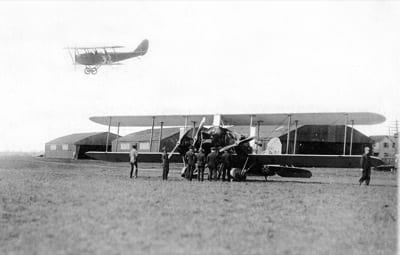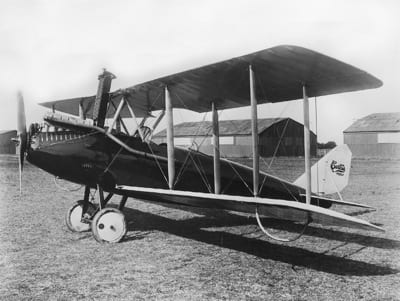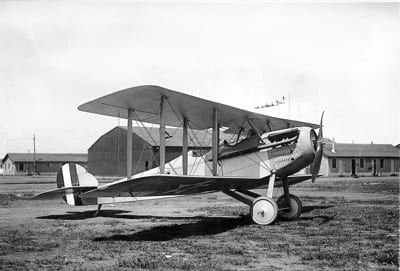
Great aerial adventures followed in the wake of World War I as aviation tried to find its post-war role.
It was a period of conquest of the oceans and continents — the NC-4 across the Atlantic via the Azores; Alcock and Brown’s first non-stop flight from Canada to Ireland; the R-34 airship’s first round-trip flight from Europe to America; and the start of large scale aerial competition.
June 25, 1919, saw the announcement of an International Aerial Derby, which would start simultaneously from Toronto and New York’s Mineola Field Aug. 25.
The Prince of Wales was the official starter at Toronto, while General William Mitchell was at the New York start. A prize of $10,000 was offered by John Bowman, president of the Hotel Commodore in New York. There were prizes for speed and performance based on a handicap formula. It was promoted as the “biggest aeronautical sporting event in the history of aviation.”
The event was sponsored by the American Flying Club of New York and the Aero Club of Canada. The contestants were to start simultaneously from New York and Toronto over a round-trip circuit with compulsory control and inspection stops at Buffalo, Syracuse and Albany. The total distance covered was about 1,040 miles.
The object of the contest was to “promote the science and sport of aviation in a manner reflecting its safety, and reliability” and was open to all types of airplanes except seaplanes.
In the speed contest the plane making the return trip in the shortest time was to be declared the winner, while in the handicap contest the standing of each airplane was determined by a formula calculating the ideal and actual performance of each aircraft. The ratio of the ideal to the actual performance gave the plane’s performance percentage.

There was great interest in the competition as witnessed by the 52 entrants. The entries represented a great variety of designs, including: DH-4, DH-9, L-W-F, Vought VE-7, Curtiss Oriole, Avro Mono, SE-5, S.V.A, Fokker D-VII, a Caproni tri-motor bomber, and a batch of Curtiss Jennies. The race was run under the direction of Chance Vought, chairman of the contest committee of the American Flying Club, who was assisted by Major-General Charles Mwenoher, director of the U.S. Air Service.
Army pilots were authorized to enter the race but were not eligible to win any prizes. As the war had been over for less than a year and civil flying just beginning, Army aircraft provided the bulk of the entries. The Air Service also provided personnel for the various control stops on the race route. The Army Coast Artillery provided search lights at each landing field to aid pilots who arrived after dark.
The rules gave the contestants two days (daylight to dark) to complete the round trip. At the control stops, each pilot was to circle the field once, land, refuel, remain 30 minutes and, after receiving clearance, take off again.
Of the 52 entries, 28 finished the round-trip. Throughout the race severe wind, rain and hail storms were encountered but, notwithstanding, several speed records were established, the most noteworthy being that of Lt. B.W. Maynard, who, piloting a DH-4 with a Liberty engine, recorded an average speed of 133 mph.
The handicap race, in which the machines competed against their own theoretical performances, was won by Maj. Rudolph Shroeder flying a Vought VE-7, equipped with a 150-hp Hispano-Suiza motor.

Roland Rohlfs, piloting a Curtiss Oriole with a 150-hp Kirkham motor, was the first civilian to finish and established the fastest time among the civilian entries (averaging 95 mph). He also took third place in the handicap event.
The Curtiss Aeroplane and Motor Corp. made an enviable showing at the aerial derby. Curtiss flyers captured $7,450 of the total prize money, finishing first, second and third in the handicap race and first and second in the speed contest. Of the six Curtiss planes entered in the contest, five — two Jennies, one Oriole, and one Standard J-1 — finished the race, with four winning prizes.
Richard Depew Jr., in a 90-hp JN-4D, finished fifth in actual performance and was only surpassed by machines that had 150 horsepower. C. S. (Casey) Jones, who finished second in both the handicap and speed events with a Curtiss JN-4D, flew a remarkable race. Leaving Mineola with a passenger, he arrived in Toronto and decided to enter the race there. He completed the speed race in second place after flying 1,560 miles with a passenger.
The results of the race had to provide good advertising for the Curtiss corporation as it was not only selling refurbished war surplus Jennies on the civilian market — for $2,500 to $3,500 each — but also was marketing the brand new Oriole — at $7,500 — designed for the civil market. Both apparently sold well until the government decided to put its surplus planes and engines on the market, just about wiping out a budding industry.
In post-war America, the public became more aware of aviation and its potential. Events such as the New York–Toronto International Air Race helped catch that attention.
Dennis Parks is Curator Emeritus of Seattle’s Museum of Flight. He can be reached at [email protected].
